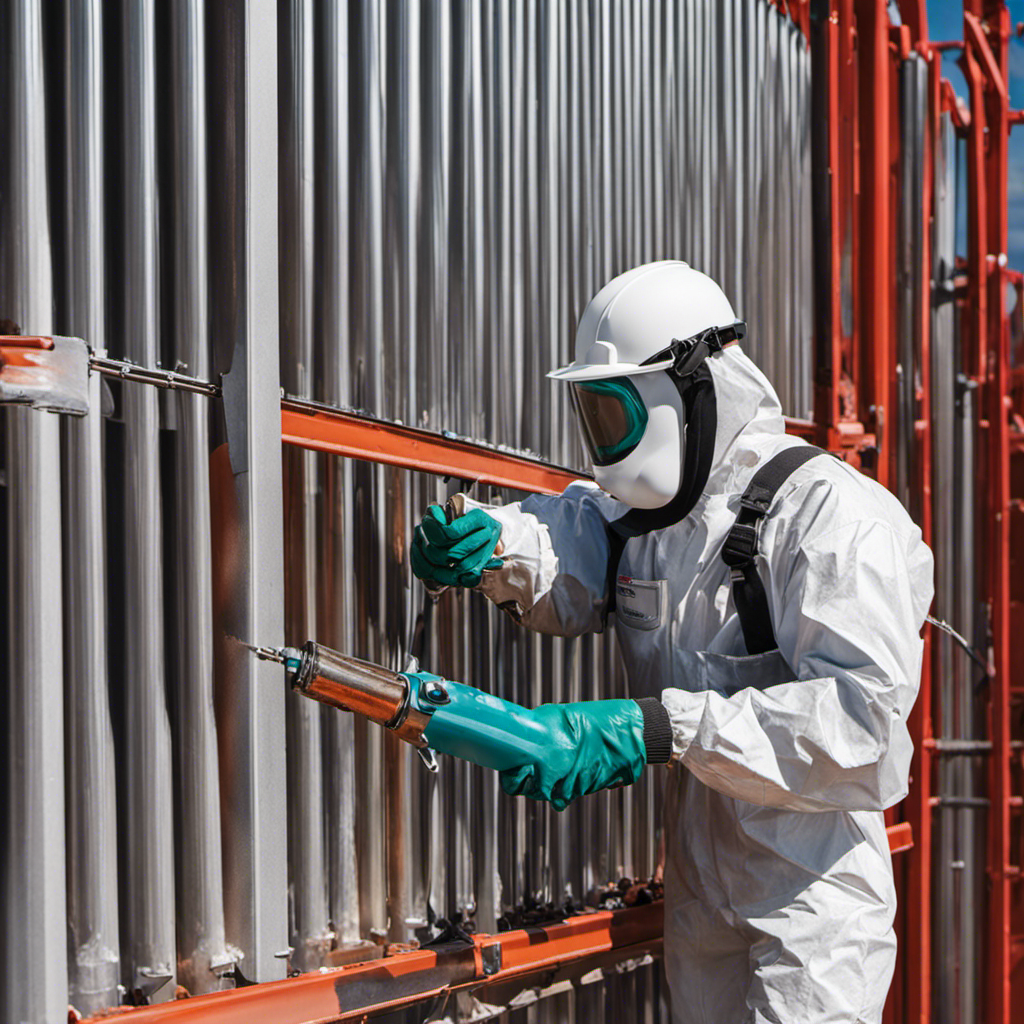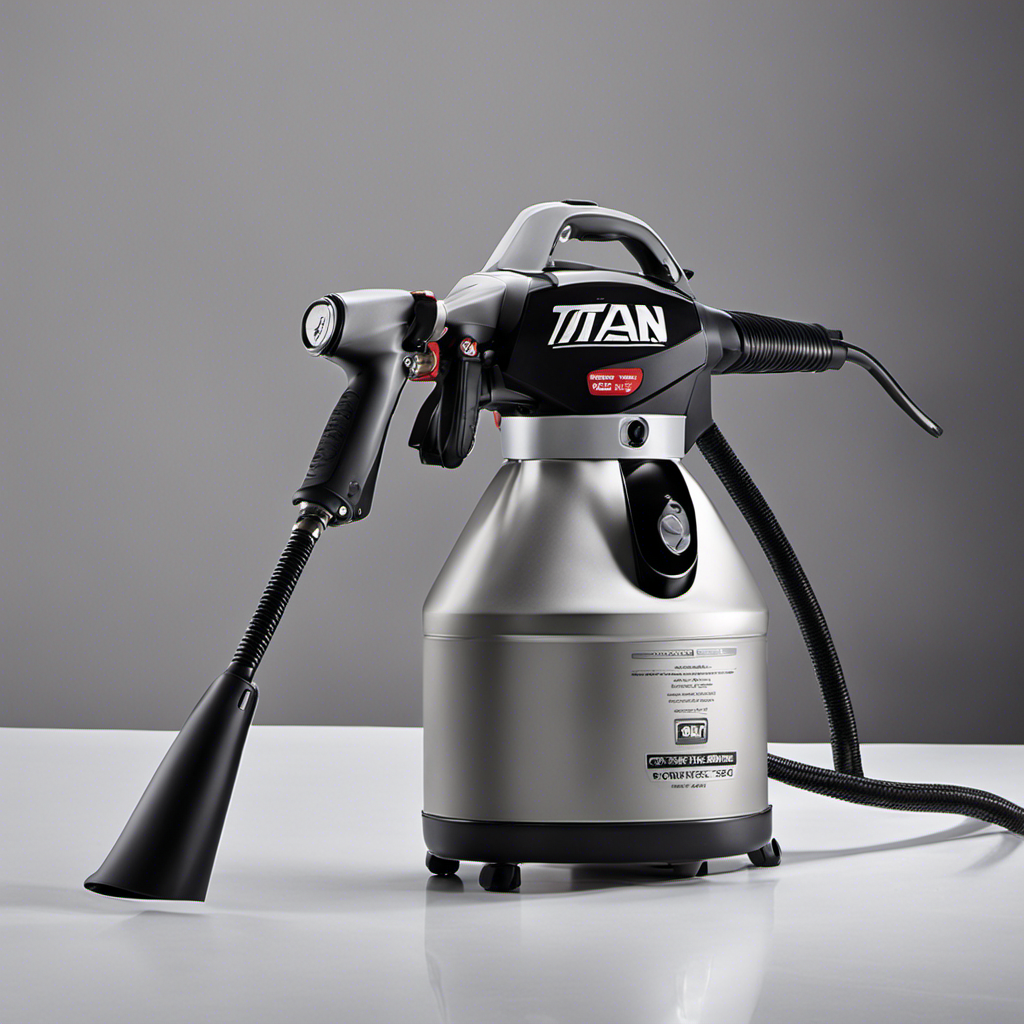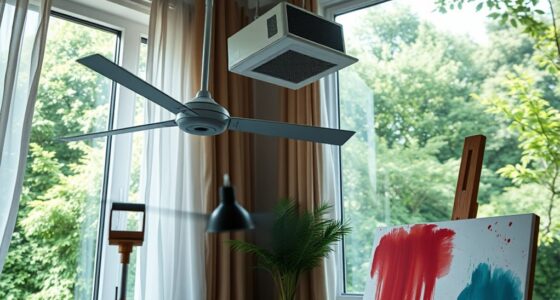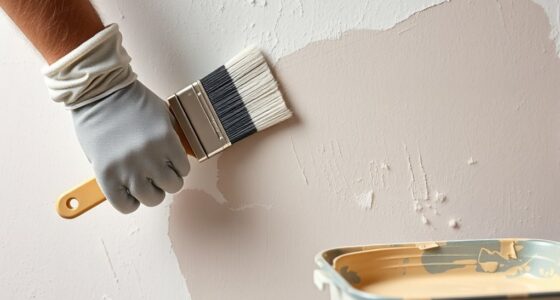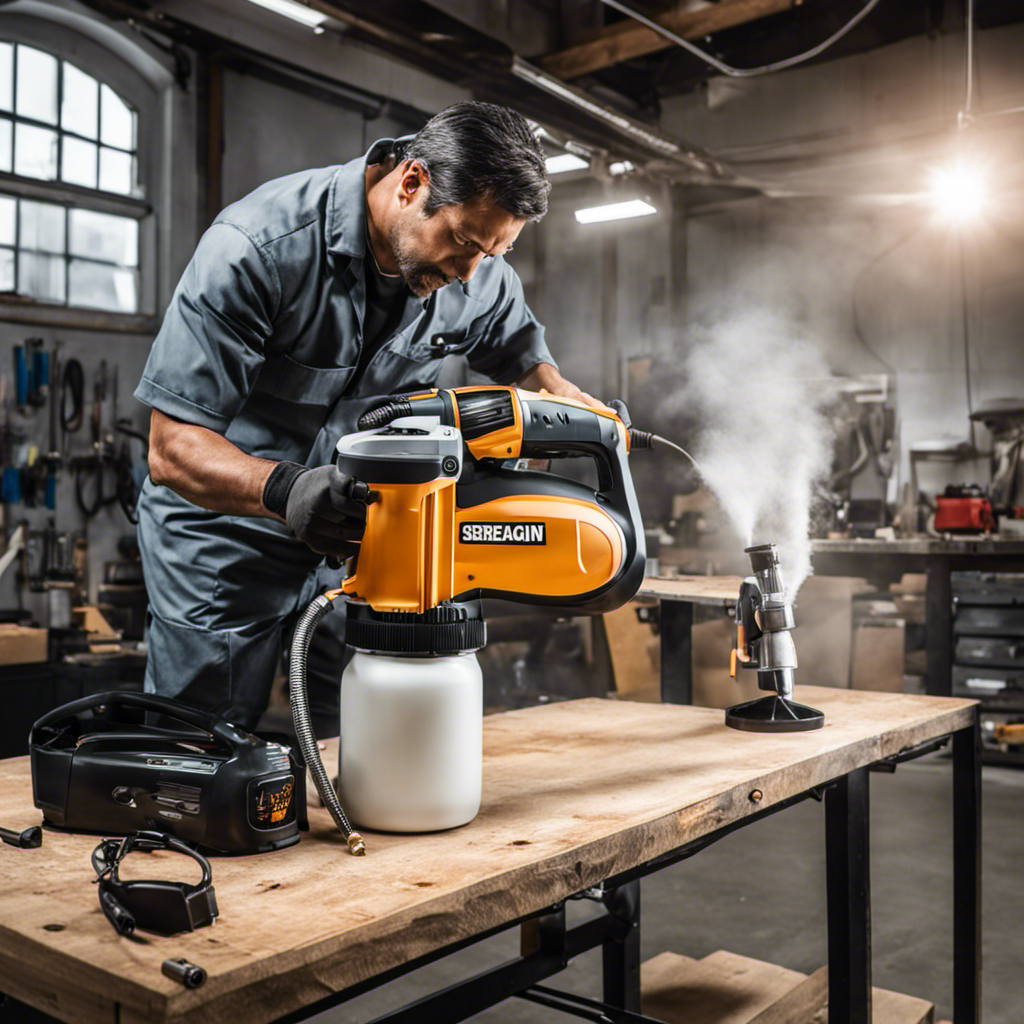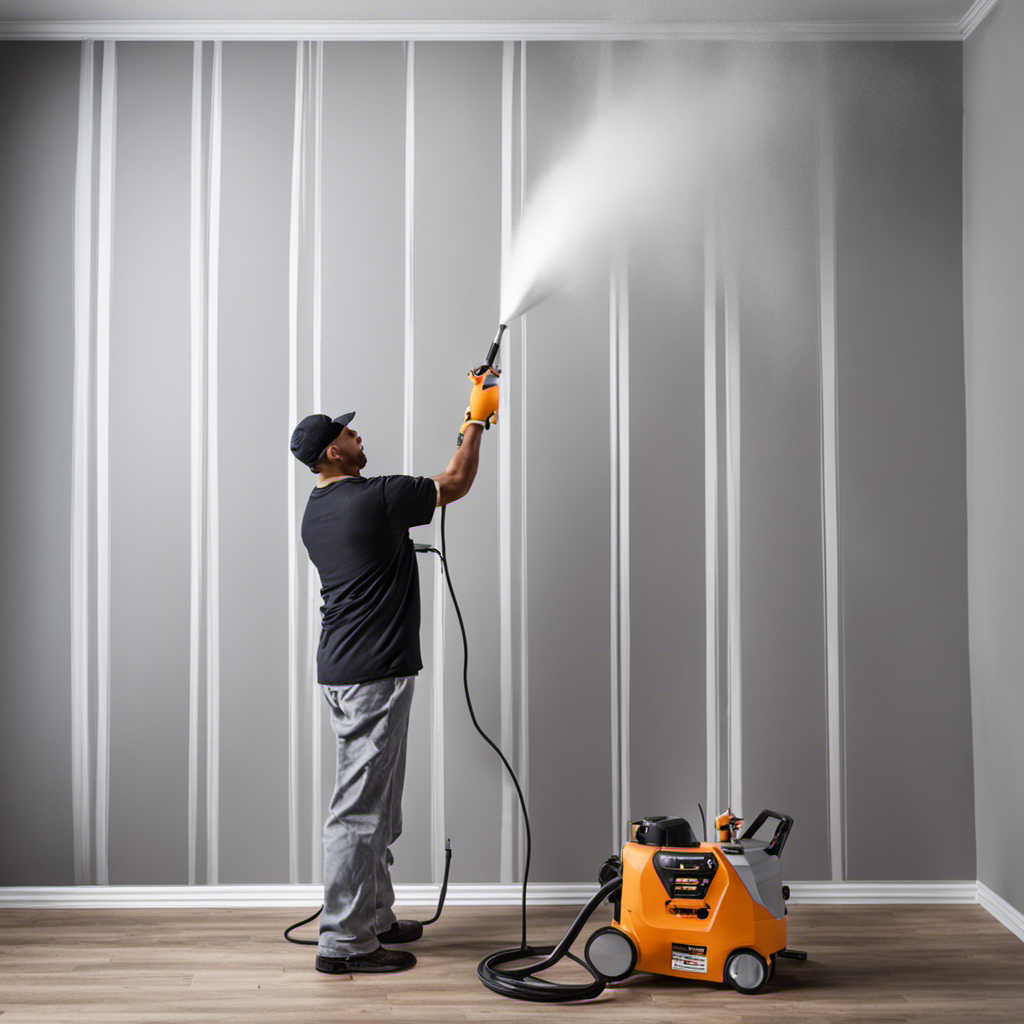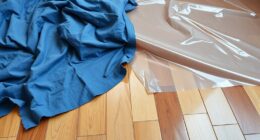Considering using an airless sprayer to apply paint can help improve and safeguard your pipe fence.
This method offers a range of benefits, including protection against rust, corrosion, and moisture seepage, as well as a boost in aesthetic appeal and property value.
By choosing the right paint color, sanding the surface, and applying a coat of primer, you can ensure a long-lasting and visually appealing result.
With the right technique and equipment, painting your pipe fence has never been easier.
Key Takeaways
- Painting your pipe fence with an airless sprayer provides protection against rust, corrosion, moisture seepage, and rot.
- It enhances the aesthetic appeal and property value of your pipe fence.
- Using an airless sprayer ensures efficient and even application of paint, resulting in a strong bond that resists peeling and flaking.
- Painting with an airless sprayer is a faster process compared to other methods.
Benefits of Painting Your Pipe Fence With an Airless Sprayer
Using an airless sprayer to paint your pipe fence offers benefits such as protection against rust, corrosion, moisture seepage, and rot, as well as enhancing its aesthetic appeal and property value.
The use of a paint sprayer for fence painting provides a more efficient and even application of paint, ensuring thorough coverage and a smooth finish. The high-pressure spray from the airless sprayer allows the paint to penetrate into the surface of the pipe, creating a strong bond that resists peeling and flaking.
Additionally, the airless sprayer allows for faster painting, reducing the overall time and effort required for the project. To achieve a smooth and even finish with an airless sprayer, it is important to choose the right paint color designed for metal, properly prepare the surface by sanding and applying a primer, and practice proper technique and safety precautions during the painting process.
Choosing the Right Paint Color for Your Pipe Fence
To ensure a visually pleasing outcome, it is important for individuals to select a paint color specifically designed for metal when considering painting their pipe fence. Choosing the right paint color for your pipe fence is crucial in achieving the desired aesthetic appeal and long-lasting protection.
When it comes to selecting the best paint brands for painting a pipe fence, there are several options available in the market. Some popular choices include Rust-Oleum, Sherwin-Williams, and Behr. These brands offer a wide range of colors specifically formulated for metal surfaces, ensuring excellent adhesion and durability.
It is recommended to consult with professionals or refer to the manufacturer’s recommendations to determine the best paint color for your pipe fence based on your specific needs and preferences.
Sanding the Surface for Proper Paint Adhesion
Before painting, it is necessary to sand the surface of the pipe fence to ensure proper adhesion of the paint. Surface preparation is crucial in achieving a long-lasting and professional finish. Here are three important paint adhesion techniques to consider:
-
Clean the surface: Remove any dirt, dust, or debris from the pipe fence using a stiff brush or pressure washer. This step ensures that the paint adheres properly and prevents any contaminants from affecting the finish.
-
Remove rust and loose paint: Use sandpaper or a wire brush to remove any rust or loose paint. This step helps create a smooth and even surface for the paint to adhere to.
-
Smooth out rough areas: Pay attention to any rough or uneven areas on the pipe fence. Sand them down using sandpaper or a sanding block to create a uniform surface for the paint.
Applying a Coat of Primer to Protect Against Rust and Corrosion
After cleaning and sanding the surface of the pipe fence, it is important to apply a coat of primer to provide an additional layer of protection against rust and corrosion.
Choosing the right type of primer for your pipe fence is crucial. Look for a primer specifically designed for metal surfaces, as it will adhere better and offer superior protection. Rust-inhibiting primers are highly recommended, as they create a barrier that prevents moisture and oxygen from reaching the metal, reducing the risk of rust formation.
When applying the primer, follow these tips for proper application: ensure the surface is clean and dry, use a brush or roller to apply an even coat, and allow sufficient drying time before applying the topcoat.
Applying a coat of primer is a vital step in the painting process to ensure the longevity and durability of your pipe fence.
Gathering Necessary Materials and Equipment for Painting
Gathering all the required materials and equipment is essential for successfully completing the painting process of the pipe fence.
To ensure a smooth and efficient painting experience, it is important to choose the right type of paint for your pipe fence. Consider using a paint color specifically designed for metal surfaces, as this will provide optimal protection and durability.
Additionally, proper maintenance and care for painted pipe fences are crucial for their longevity. Regular inspections and touch-ups as needed will help prevent rust, corrosion, and other forms of damage.
It is also important to clean up and properly store your painting equipment after each use.
Setting up a Proper Work Area for Painting Your Pipe Fence
Setting up a suitable workspace is crucial for a smooth and efficient painting process when working on a pipe fence. To ensure proper ventilation during the painting process, it is important to choose an area with adequate airflow. This can be achieved by opening windows or using fans to circulate the air.
Additionally, it is necessary to clear the work area of any debris or obstructions that could hinder the painting process. A clean and organized workspace will allow for better maneuverability and accessibility to all areas of the fence.
It is also essential to protect the surrounding surfaces by covering them with drop cloths or plastic sheets. By setting up a proper work area for painting your pipe fence, you can ensure a safe and effective painting process.
Organizing Tools and Laying Down a Drop Cloth for a Clean Work Environment
To create a safe and clean work environment while painting your pipe fence with an airless sprayer, it is important to organize your tools efficiently and lay down a drop cloth. Here are some tips to help you achieve this:
-
Organize tools efficiently: Keep your paint cans, brushes, and other tools within easy reach. Use a tool belt or toolbox to keep everything organized and minimize the time spent searching for items.
-
Lay down a drop cloth: Before starting the painting process, lay down a drop cloth to protect the ground from paint drips and spills. This will help keep your work area clean and prevent accidents.
-
Create a safe work environment: Make sure your work area is well-lit and free from any tripping hazards. Remove any clutter or obstacles that may impede your movement. Additionally, wear appropriate protective gear such as goggles, gloves, and a mask to protect yourself from paint fumes and splatters.
Practicing Proper Safety Precautions While Painting With an Airless Sprayer
Practicing proper safety precautions is essential when using an airless sprayer. The painter should wear goggles, gloves, and a mask to protect themselves from paint fumes and splatters. Safety gear is important to prevent eye and skin irritation, as well as inhalation of harmful chemicals present in paint.
In addition to wearing safety gear, proper ventilation is crucial for a safe working environment. Adequate airflow helps dissipate paint fumes and reduces the risk of respiratory issues. It is recommended to work in a well-ventilated area or use exhaust fans to remove airborne particles.
To further minimize exposure to paint fumes, the painter should take breaks in well-ventilated spaces. This will help protect their health and ensure they can complete their work safely.
Starting the Painting Process With the Right Technique and Angles
Using the proper technique and angles, the painter can ensure an even and smooth application of paint on the underside of the pipe fence. Starting the painting process with the right technique is crucial to achieve a professional finish when using an airless sprayer.
Here are some tips and tricks to avoid common mistakes:
- Properly prepare the surface by cleaning and removing any rust or loose paint.
- Use a primer designed for metal to improve adhesion and protect against corrosion.
- Choose the correct spray tip size for the type of paint being used and the desired coverage.
Achieving a professional finish requires attention to detail and precision. The painter should maintain a consistent distance from the surface and use overlapping strokes to ensure even coverage. It is also important to avoid overspray and reach hard-to-access areas by adjusting the spray pattern and angle of the sprayer.
Avoiding Overspray and Reaching Hard-To-Access Areas of Your Pipe Fence
The painter can achieve an even application of paint on hard-to-access areas of the pipe fence by adjusting the spray pattern and angle of the sprayer. By using specific techniques and angles, they can avoid overspray and ensure that every nook and cranny is properly coated. Reaching tight corners can be challenging, but with the right approach, it can be accomplished effectively. One technique is to adjust the spray pattern to a narrower width, allowing for more precision in those hard-to-reach areas. Another technique is to hold the sprayer at a slight angle, directing the paint towards the targeted spot. This helps to avoid excessive overspray and ensures that the paint is evenly distributed. With these techniques, the painter can achieve a professional finish on their pipe fence.
| Technique | Description |
|---|---|
| Adjust spray pattern | Narrow the width for precision |
| Hold sprayer at an angle | Direct paint towards target area |
| Use a smaller nozzle | Helps to reach tight corners |
Inspecting and Touching up Your Painted Pipe Fence as Needed
After successfully painting your pipe fence with an airless sprayer, it is essential to inspect and touch up the painted surface as needed. Regular maintenance ensures that your fence remains in optimal condition and continues to enhance the overall aesthetic appeal of your property.
Inspecting the painted pipe fence allows you to identify any areas that may require touch-ups. By addressing these areas promptly, you can prevent rust spots from forming and maintain the fence’s color and shine.
To touch up the painted surface, gather the necessary materials, such as the paint color used initially and a small brush or roller. Apply a thin layer of paint to the affected areas, ensuring even coverage.
Cleaning up and Properly Storing Your Painting Equipment
Once the painting process is complete, it is important for the painter to clean up and properly store their equipment. This not only ensures the longevity of the equipment but also promotes a safe working environment. Proper cleaning and storage practices prevent the build-up of paint residue, which can affect the performance of the equipment in future projects.
To convey the importance of cleaning and storing equipment, a table can be used to outline the necessary steps and safety precautions. The table would consist of two columns and three rows, with the first column listing the steps and the second column detailing the safety precautions. This visual representation allows the audience to quickly understand and follow the process.
Below is an example of the table:
| Step | Safety Precautions |
|---|---|
| Clean paint brushes and rollers | Wear gloves and protective eyewear |
| Dispose of paint properly | Follow local regulations for paint disposal |
| Store equipment in a dry place | Keep away from heat sources and flammable materials |
Admiring the Enhanced Aesthetic Appeal of Your Newly Painted Pipe Fence
Upon completion of the painting process, the painter can appreciate the newly revitalized appearance of their pipe fence. The fresh coat of paint enhances the overall curb appeal of the property, adding a touch of elegance and sophistication.
A well-painted pipe fence not only provides a visually appealing boundary but also increases the value of the property. However, it is crucial to remember the importance of regular maintenance to ensure the longevity of the painted pipe fence.
Regular inspections should be conducted to identify any signs of damage, such as rust or peeling paint, and address them promptly. Additionally, periodic touch-ups may be required to maintain the fence’s pristine appearance and protect against the elements.
Performing Regular Inspections to Ensure the Durability and Longevity of Your Pipe Fence
After admiring the enhanced aesthetic appeal of a newly painted pipe fence, it is important to perform regular inspections to ensure its durability and longevity. By performing regular maintenance, you can identify common problems and address them promptly, preventing further damage and prolonging the lifespan of your fence.
To emphasize the importance of performing regular inspections, here is a table highlighting some common problems that may arise with a pipe fence:
| Common Problems | Causes | Solutions |
|---|---|---|
| Rust and corrosion | Exposure to moisture and harsh weather conditions | Regularly inspect and touch up with rust-resistant paint |
| Loose or damaged components | Wear and tear over time | Replace or repair damaged components |
| Fence leaning or sagging | Improper installation or ground shifting | Reinforce fence posts and ensure proper alignment |
Addressing Common Concerns and Troubleshooting Tips for Painting With an Airless Sprayer
To troubleshoot common concerns when using an airless sprayer, individuals should ensure that the paint color chosen is specifically designed for metal surfaces and practice proper safety precautions.
Some common mistakes to avoid include using the wrong paint color, failing to properly prepare the surface, and not practicing proper spraying techniques.
Troubleshooting techniques for these concerns include selecting a paint color that is specifically designed for metal surfaces to ensure proper adhesion and durability. Additionally, individuals should thoroughly clean and sand the surface to remove any rust or loose paint before applying a coat of primer.
It is also important to practice proper spraying techniques, such as maintaining the correct distance and angle, to ensure even coverage and avoid overspray.
Frequently Asked Questions
Can I Use a Regular Paintbrush or Roller Instead of an Airless Sprayer to Paint My Pipe Fence?
Using a regular paintbrush or roller instead of an airless sprayer to paint a pipe fence has its pros and cons. While it may be a more affordable option and allow for more control, it can be time-consuming and may not provide as even of coverage.
To achieve a professional finish without an airless sprayer, proper technique is key. It’s important to apply thin, even coats and to take the time to cover hard-to-reach areas.
Ultimately, the choice between a regular paintbrush and an airless sprayer depends on personal preference and the desired outcome.
How Long Does It Take for the Paint to Dry on a Pipe Fence After Using an Airless Sprayer?
The paint on a pipe fence typically dries within a few hours after using an airless sprayer. However, the exact drying time can vary depending on factors such as temperature and humidity.
It is important to allow sufficient time for the paint to fully dry before touching or applying additional coats.
Following proper preparation techniques, such as cleaning and sanding the surface, and choosing the right paint color for your pipe fence can help ensure optimal drying and long-lasting results.
Is It Necessary to Apply a Second Coat of Paint for Better Protection and Durability?
Applying a second coat of paint to a pipe fence after using an airless sprayer is not necessary for better protection and durability.
The benefits of using primer before applying the first coat of paint include improved adhesion and enhanced durability.
Properly cleaning and preparing the surface of a pipe fence before painting involves sanding to remove rust and loose paint, applying a coat of primer, and choosing a paint color designed for metal.
Can I Paint My Pipe Fence in Cold or Humid Weather Conditions?
In the world of pipe fence painting, there are certain painting techniques that must be followed. One of the most important factors to consider is the weather conditions in which you choose to paint.
It is highly recommended to avoid painting your pipe fence in cold or humid weather conditions. These conditions can affect the drying time and adhesion of the paint, resulting in a subpar finish.
It is best to wait for more favorable weather conditions to ensure a successful paint job.
What Should I Do if I Accidentally Get Paint Overspray on Nearby Plants or Surfaces?
To safely remove paint overspray from nearby plants and surfaces, there are a few steps to follow.
First, wipe off any wet paint with a cloth or paper towel.
For dried paint, carefully scrape it off using a plastic scraper or a putty knife.
If the overspray is stubborn, use a mild solvent like rubbing alcohol or paint thinner. Apply it with a cloth and gently rub the affected area.
To prevent paint overspray, cover nearby plants and surfaces with plastic sheets or drop cloths before beginning the painting process.
Conclusion
In conclusion, painting your pipe fence with an airless sprayer is a meticulous process that yields numerous benefits.
By choosing the right paint color, sanding the surface, and applying a coat of primer, you can protect your fence from rust, corrosion, and moisture seepage.
Additionally, this method enhances the aesthetic appeal and property value of your fence.
By properly setting up your work area, gathering the necessary materials, and using the correct technique, you can achieve a long-lasting and visually pleasing result.
Regular inspections and maintenance will ensure the durability and longevity of your pipe fence.
So, why wait? Transform your fence today and enjoy the countless advantages it brings!
Drenched in creativity and armed with a fountain pen, Isolde weaves words as gracefully as a painter strokes their canvas. A writer for Paint Sprayer Zone, her passion for colors, textures, and spaces finds a harmonious blend with her profound knowledge of painting tools and techniques.
Having grown up in a family of artists, Isolde’s tryst with paints began early. While her relatives expressed themselves on canvas, Isolde found her medium in words. She dedicated herself to chronicling the world of painting, understanding the nuances of each tool, and the artistry behind every spritz of a paint sprayer.
